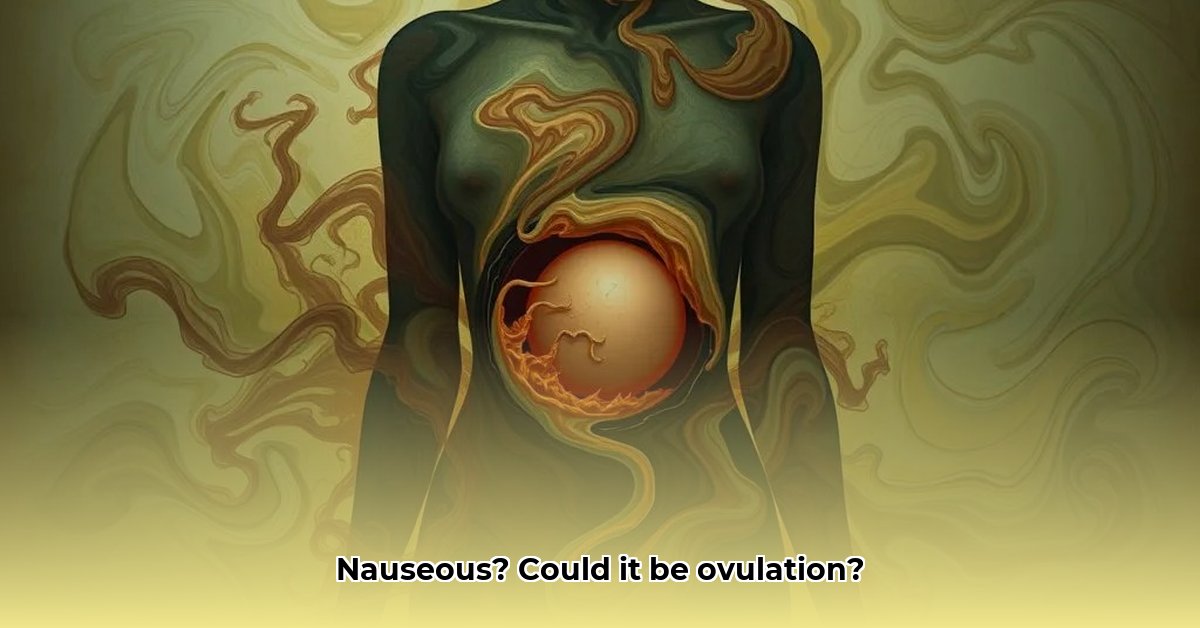Experiencing nausea mid-cycle? You’re not alone. Many women experience a wave of queasiness around ovulation. This guide will explain why ovulation can sometimes cause nausea, address common misconceptions about pregnancy, and offer practical tips for finding relief.
The Science Behind Ovulation Nausea
Myth vs. Fact: Is it a Sign of Pregnancy?
Myth: Ovulation nausea is a sign of pregnancy.
Fact: Ovulation nausea is not an early sign of pregnancy. Nausea during ovulation occurs before implantation (when a fertilized egg attaches to the uterine wall). It’s simply too early for pregnancy-related nausea to appear. A missed period, not mid-cycle nausea, is the first reliable sign of possible pregnancy.
Hormonal Shifts and Their Effects
Your menstrual cycle involves a complex interplay of hormones. Just before ovulation, there’s a surge in estrogen and luteinizing hormone (LH). While crucial for fertility, these hormonal fluctuations can sometimes affect your digestive system, potentially causing nausea. Some experts suggest that the subsequent drop in estrogen following ovulation might also contribute to nausea, though research is ongoing. Progesterone levels also rise after ovulation, but its connection to nausea is less clear.
Mittelschmerz and its Link to Nausea
Some women experience a brief, sharp pain during ovulation called mittelschmerz, often on one side of the lower abdomen near the ovaries. This pain, likely caused by the stretching of the ovarian wall as the egg is released, can be accompanied by nausea. The exact link isn’t fully understood, but it’s thought that the discomfort from mittelschmerz may trigger or exacerbate nausea in some individuals.
Managing Ovulation Nausea: A How-To Guide
Feeling queasy? Here’s how to find relief:
-
Hydration is Key: Dehydration can worsen nausea. Sip water, clear broths, or electrolyte drinks throughout the day.
-
Soothing Ginger: Ginger has long been used to settle upset stomachs. Try ginger ale or ginger tea.
-
Bland Foods are Best: Stick to easy-to-digest foods like toast, crackers, or plain rice.
-
Peppermint Power: A warm cup of peppermint tea can soothe your stomach.
-
Distraction Techniques: Engaging in enjoyable activities can sometimes help take your mind off the nausea.
-
Gentle Warmth: Applying a warm compress or heating pad to your lower abdomen can provide some comfort. Caution: If you’re trying to conceive, consult your doctor before using heat on your abdomen, as some studies suggest it may be detrimental.
-
Over-the-Counter Relief (with Caution): Over-the-counter pain relievers like ibuprofen or naproxen may help manage mittelschmerz and associated nausea. Caution: If you’re trying to conceive, consult your doctor before using these medications, as they may interfere with ovulation or implantation.
-
Birth Control as an Option: If ovulation-related nausea significantly impacts your quality of life and you are not planning a pregnancy, hormonal birth control pills can prevent ovulation and thus eliminate the associated symptoms. Discuss this option with your healthcare provider.
When to Consult Your Doctor
While ovulation nausea is typically mild and temporary, seek medical advice if you experience:
- Severe Pain: Intense or prolonged abdominal pain.
- Persistent Nausea: Nausea lasting more than a few days or interfering with your daily life.
- Unusual Bleeding: Any bleeding that’s different from your usual period.
- Pain after unprotected sex: Especially if coupled with other symptoms.
- Difficulty Conceiving: If you’ve been trying to conceive without success for a year (or six months if you’re over 35), consult a fertility specialist.
Ovulation at a Glance
| Symptom | Potential Cause(s) | Remedies |
|---|---|---|
| Nausea | Hormonal fluctuations, mittelschmerz | Hydration, ginger, peppermint tea, bland foods, warmth, pain relievers (with caution), consider birth control |
| Mittelschmerz | Follicle rupture, egg release | Over-the-counter pain relievers, heating pad (with caution) |
| Breast Tenderness | Hormonal changes | Supportive bra |
| Changes in Cervical Mucus | Hormonal changes | None – This is a normal part of the menstrual cycle |
| Increased Libido | Hormonal changes | None – This is a normal part of the menstrual cycle |
| Bloating | Hormonal changes | Lifestyle changes such as increased exercise and a healthy diet may help |
Beyond Nausea: Other Ovulation Signs
- Changes in Cervical Mucus: Clear, stretchy, egg-white-like discharge around ovulation.
- Basal Body Temperature (BBT) Rise: A slight increase in BBT after ovulation. Tracking BBT can help pinpoint ovulation, but it’s important to remember that many factors can affect BBT, so it’s not a foolproof method.
Further Exploration
- Ovulation Tracking Methods
- Early Pregnancy Symptoms
- Birth Control Options
Disclaimer: This information is for educational purposes only and does not substitute professional medical advice. Consult a healthcare provider for any health concerns or before making any decisions related to your health or treatment.
- Glass Lunch Box Containers Offer Healthy, Leak-Proof Meal Prep - December 21, 2025
- Glass Bento Boxes Offer a Healthy, Eco-Friendly Lunch Solution - December 20, 2025
- Glass Bento Containers Make Packing Lunch Easier and Healthier - December 19, 2025










